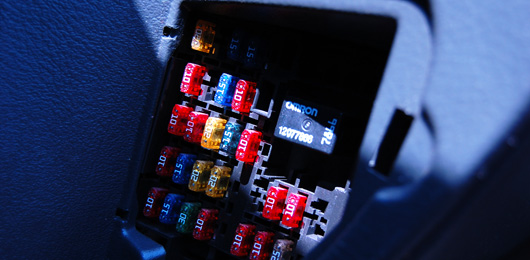Last week in Part 1 of Grease Monkey we talked about Oil and Transmission Changes and Radiator Flushes.
Car a little slow to brake? Turn signal blinking rapidly? Find out when doing it yourself is the smart choice and when it's time to hand over the dough.
In this guide, we’ll help you make sense of all the messy jobs that a mechanic does, and a few things that you can do to save a few bucks — without wasting your precious time, so you can get back to playing — er, training — on your Wii.
By Jesse Stern
Brakes
Brakes are important. They stop your car. They can help prevent lawsuits, bruises, hospital bills, stitches, and Breaking your Mother's Heart. To determine whether to Do it Yourself or Pay a Mechanic, take this simple True/False quiz:
- I wear flannel shirts with the sleeves cut off (T/F)
- I have an older brother, or close friend, named Scooter (T/F)
- I carry, and/or blow my nose into, a cloth handkerchief (T/F)
If you answered “True” to any of these questions, you might be qualified to fix your own brakes. Otherwise….
Verdict: Pay a Mechanic!
No matter who fixes your brakes, buy the most expensive brake pads that you can reasonably afford. They will last longer, and could save your life.
Do It Yourself:
Basically, it involves removing the wheels, swapping out the brake pads, and draining air from the brake lines, a process known as “bleeding.” You will need Scooter for this, because one person has to pump the brakes while the other closes off the brake line.
Pay a Mechanic:
If you replace your brake pads when you should, the rotors (metal discs that help create car-stopping friction) should be clean and smooth. If not, they will be scored, and look like the grooves on an LP*. If the rotors are scored, you will have to have them “turned”, which means “ground smooth”, using a special machine. With decent brakes, the pads and labor should cost you around $100-200. If you need to to turn the rotors, add another couple hundred bucks to the price tag.
* Note to non-DJ's and people under 25: an LP is a black disc made of vinyl, sort of an early version of the CD**. The grooves on the LP, when scratched with a needle, created sound.
** Note to people under 20: a CD is a shiny silver disc, sort of like a single-album iPod.
Tip: If your brakes start to squeal or make a grinding noise when you slow down, this could mean the pads are wearing thin. Check them right away, and replace if necessary.
Fuses and Headlights and Such
Most of these basic problems can be solved easily with some pocket change and a trip to the parts store. There is simply no need to pay a mechanic for this. Like changing a flat, everyone should know how to identify and change a blown fuse.
Verdict: Do it Yourself!
No headlights? No wipers? No radio? No blinkers? Probably a fuse. Find your fuse box and consult the diagram (in the fuse box or in your car’s owner’s manual), to figure out which is which. A fuse is basically two pieces of metal joined by a very thin piece of metal. When a circuit gets overloaded, the thin piece breaks or burns. You can identify a burnt fuse by looking at the thin piece of metal. If it’s intact, the fuse is good. If it’s burnt or broken, the fuse is bad.
Do It Yourself:
Each fuse has a little number on it, telling how much power it can handle. At the parts store, get a box of assorted fuses. Pull out the old one with your fingers or a fuse puller (little plastic pliers that comes with your box of assorted fuses), or a set of needle-nose pliers. If it’s burnt, replace it with a new one of the same number. This should solve the problem.
Changing a car headlight (or tail light or brake light) is almost as easy as changing a light bulb in your house. The trick is getting past all the casing. You may need a screwdriver or small wrench to access the bulb. Take out the old one, bring it to the parts store, get a new one, and bingo!
Pay a Mechanic:
Resort to paying a mechanic only if you have checked the fuses, bulbs, and any obvious wires that may be unattached, loose or broken.
Alignment
Having your car aligned properly reduces friction between your tires and the road. This makes your tires last longer and saves gas. As with tire shops, alignment shops have cool, specialized equipment that looks like it belongs in Darth Vader’s meditation room. You, on the other hand, have none of this cool, specialized equipment.
Verdict: Pay a Mechanic!
Do It Yourself:
You can’t. Okay, you probably can, but it would be like driving a covered wagon across the country. Or lighting a pilot light by rubbing two sticks together. Just don’t.
Pay a Mechanic:
Alignment shops charge around $40-$50 to align the two drive wheels, or $70-$90 for all four. If you manage to avoid driving up on curbs, this should last for a long time.


















